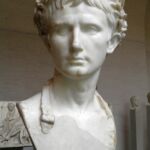Chapters
Marcus Vipsanius Agrippa was born in 63 BCE. He was an extraordinary politician and military commander. He was a son-in-law, lieutenant and a close friend of Gaius Julius Caesar Octavianus. He was his peer and they both studied in Apollonia.
Marcus was a son of Lucius Vipsanius Agrippa. His older brother had the same name as the father, whereas his sister was named Vipsania Polla. Marcus’ family did not play any important role in the public life of Rome. Since his earliest years, the young Octavian was provided with a decent education and care. He was taught Latin and Greek and how to speak them fluently. Since Marcus and Octavian were of the same age, they were being educated together and became great friends. Despite Agrippa’s association with the house of Caesar, his elder brother chose to fight on side of Pompeius in the civil wars in the 40s BCE, fighting under Cato against Caesar in Africa. When Cato’s forces were defeated, Agrippa’s brother was taken prisoner. He was, however, freed after Octavian interceded on his behalf.
Following his advice, Octavian travelled to Rome immediately after the assassination of Caesar. Agrippa played an important role in the war against Lucius Antonius and Fulvia Antonia, wife of Marcus Antonius, which ended in the capture of Perusia. Two years later, he put down a rebellion in Gaul and crossed Rhine river in order to stop the aggression of Germanic tribes. After his return, he refused an offer of a triumph, yet assumed consulate in 37 BCE. He oversaw the preparation for a war with Sextus Pompeius by extending harbors and training the fleet in the artificial harbor of Portus Julius, built near Baiae. Subsequently, as the fleet commander, he defeated Sextus Pompeius in the battles of Mylae and Naulochus in 36 BCE.
Marcus married Pomponia, daughter of Cicero’s friend, Pomponius Atticus. In 33 BCE, he became an aedil and greatly improved and embellished Rome. Once again, he became a fleet commander when the war with Marcus Antonius had begun. The victory in the sea battle of Actium over the fleet of Marcus Antonius and Cleopatra in 31 BCE was to a great degree his claim to fame. It gave Octavian the mastery of Rome and the empire. As a indication of trust of Octavian, Agrippa was bestowed upon with the hand of Octavian’s niece Claudia Marcella Major.
In 27 BCE, he assumed consulate for the third time and built the Pantheon in the remembrance of the battle of Actium. The inscriptions commemorating its foundation remained even after the reconstruction of Pantheon by Hadrian. He also built aqueducts and thermae, as well as other public buildings. As a result of plots of Livia and out of the envy of Marcus Claudius Marcellus’ influence, he ostensibly left Rome, took over the governorship of Syria, though he himself remained at Lesbos and governed it from there. After the death of Marcellus, the husband of Julia (daughter of Augustus), Octavian once again summoned Agrippa to Rome. In order to strengthen the relationships with Agrippa, Octavian induced him to divorce Marcella and marry his daughter, Julia the Elder, who was the widow of Marcellus. They got married in 21 BCE.
In 19 BCE, Agrippa managed to put down the rising of Cantabrians in Spain, and in 17 BCE he again became a governor of Syria, where he got credit for his ruling. He was also a great geographer, as he created a map of the contemporary world, which Octavian Augustus ordered to be placed in a portico called Porticus Vipsania. In addition to this map, Agrippa made a geographical comment, which for sure mainly consisted of data concerning borders and distance. Moreover, he wrote an autobiography, which, unfortunately, did not remain until our times, as is the case with any other work of his.
Death
He died in 12 BCE in Campania, at the age of 51. Augustus marked him by a great funeral and burial in Augustus’ mausoleum.
Marriage and offspring |
|










